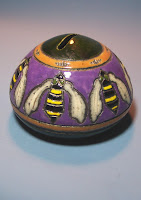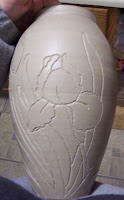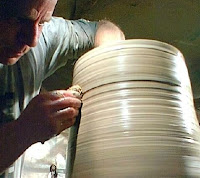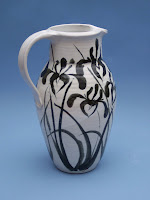
These mums are one of the first things I see as I come out my door. Such a cheery sight with the sunlight falling upon them like this, I felt I had to share them.

 I have tried many kinds of hand creams to keep my hands from drying out and cracking over the years, but not very many actually penetrate the skin or do much good. The two ones I've had the best luck with are Corn Huskers Lotion and Bee Balm Lotion (BeeBalm is actually my favorite). Both can be bought at my local pharmacy, and the Bee Balm can even be bought through at least one of my pottery suppliers.
I have tried many kinds of hand creams to keep my hands from drying out and cracking over the years, but not very many actually penetrate the skin or do much good. The two ones I've had the best luck with are Corn Huskers Lotion and Bee Balm Lotion (BeeBalm is actually my favorite). Both can be bought at my local pharmacy, and the Bee Balm can even be bought through at least one of my pottery suppliers. I also found these handy dandy little First Aid Cots in the bandage section of the pharmacy, right by the New Skin, bandaids, etc... They roll on like little finger condoms and can even go over a bandage, keeping your digit dry and clean. Much more localized coverage than a latex glove, although just as effective. They work great.
I also found these handy dandy little First Aid Cots in the bandage section of the pharmacy, right by the New Skin, bandaids, etc... They roll on like little finger condoms and can even go over a bandage, keeping your digit dry and clean. Much more localized coverage than a latex glove, although just as effective. They work great. "...eat hearty soups, drink assorted beverages, munch on artisan breads and gourmet cookies, dance to a great band, BAYRUNNER this year, and at the end of the evening take our bowl home."
"...eat hearty soups, drink assorted beverages, munch on artisan breads and gourmet cookies, dance to a great band, BAYRUNNER this year, and at the end of the evening take our bowl home."
 Throwing pots on the wheel, in reality, only represents a small portion of what goes into producing a finished pot. For every two three days of throwing, there are four or 5 days of doing other tasks. Pots still need to be trimmed, have handles attached and decoration applied, and patiently monitored as they dry slowly before they are loaded into the bisque kiln. If they survive the bisque firing , they are then glazed and loaded into the gas kiln. Because our shelves are so badly warped we also "wad" the bottoms of our pots before the final firing (wadding: dry china clay and alumina hydrate mixed and formed into balls which are strategically stuck to the bottom of the pots to evenly support the base of the pot on the kiln shelf).
Throwing pots on the wheel, in reality, only represents a small portion of what goes into producing a finished pot. For every two three days of throwing, there are four or 5 days of doing other tasks. Pots still need to be trimmed, have handles attached and decoration applied, and patiently monitored as they dry slowly before they are loaded into the bisque kiln. If they survive the bisque firing , they are then glazed and loaded into the gas kiln. Because our shelves are so badly warped we also "wad" the bottoms of our pots before the final firing (wadding: dry china clay and alumina hydrate mixed and formed into balls which are strategically stuck to the bottom of the pots to evenly support the base of the pot on the kiln shelf). A friend of mine similarly had some very bad luck with some commercial clay (for which, incidentally, the shipping cost more than the clay) she made all of her pots out of for her fall show season. A week after her big fall sale, a customer brought back $300 worth of pots, then another customer did the same. All or most of the pots had quarter-cent sized hunks of the side of the pot popping off. Lime pop-outs apparently, which can take up to 3 months after the firing to appear. Months of work, large financial commitments (show fee, natural gas, clay, etc), and possibly her reputation tarnished, all because of a faulty raw material or the clay not being mixed properly by the supplier. The supplier was very gracious to replace the clay, but the propane has been burned, the pots have been sold, the money has already been spent, and the remainder of her inventory is questionable... and her pride bruised.
A friend of mine similarly had some very bad luck with some commercial clay (for which, incidentally, the shipping cost more than the clay) she made all of her pots out of for her fall show season. A week after her big fall sale, a customer brought back $300 worth of pots, then another customer did the same. All or most of the pots had quarter-cent sized hunks of the side of the pot popping off. Lime pop-outs apparently, which can take up to 3 months after the firing to appear. Months of work, large financial commitments (show fee, natural gas, clay, etc), and possibly her reputation tarnished, all because of a faulty raw material or the clay not being mixed properly by the supplier. The supplier was very gracious to replace the clay, but the propane has been burned, the pots have been sold, the money has already been spent, and the remainder of her inventory is questionable... and her pride bruised. When you first start learning how to make pottery, you follow your teacher's lead. You follow the same techniques, use the same tools, and emulate your teacher as best as you can. You take what you learn with you throughout your potting career. Lowell's favourite thing to say to students as they start out is "First you learn the rules, then you learn there are no rules". Sure, there are other ways to do the same thing, but as with learning a language, getting a good foundation in the fundamentals is important.
When you first start learning how to make pottery, you follow your teacher's lead. You follow the same techniques, use the same tools, and emulate your teacher as best as you can. You take what you learn with you throughout your potting career. Lowell's favourite thing to say to students as they start out is "First you learn the rules, then you learn there are no rules". Sure, there are other ways to do the same thing, but as with learning a language, getting a good foundation in the fundamentals is important.


 Since I moved my wheel outside, I've noticed a surprising number of new little creatures that I probably wouldn't normally see on my usual trip to the studio. Gekkos, Red headed skinks (a lizard), blue racer skinks, crab spiders, a rainbow of different colored dragonflies, etc., all going about their business seemingly undisturbed by my presence and the constant hum of the wheel. A great place to look for design inspiration.
Since I moved my wheel outside, I've noticed a surprising number of new little creatures that I probably wouldn't normally see on my usual trip to the studio. Gekkos, Red headed skinks (a lizard), blue racer skinks, crab spiders, a rainbow of different colored dragonflies, etc., all going about their business seemingly undisturbed by my presence and the constant hum of the wheel. A great place to look for design inspiration. Absolutely beautiful day out today, here on the coast. While I do miss my fall days in Canada, on days like today, they couldn't be further from my mind. Low humidity, sunny, slight breeze, and in the 80s F.
Absolutely beautiful day out today, here on the coast. While I do miss my fall days in Canada, on days like today, they couldn't be further from my mind. Low humidity, sunny, slight breeze, and in the 80s F. I think I may do it all over again tomorrow. No rain in the forecast until later in the week.
I think I may do it all over again tomorrow. No rain in the forecast until later in the week.
 I've been out of commission for almost a week now with a bad head cold. I have no idea where I picked it up, but it hit me like a truck early Saturday morning as I was getting ready to go run my usual errands.
I've been out of commission for almost a week now with a bad head cold. I have no idea where I picked it up, but it hit me like a truck early Saturday morning as I was getting ready to go run my usual errands.  Took the opportunity to snap a few photos in the gap between when my customer left and my daughter's school bus was to arrive.
Took the opportunity to snap a few photos in the gap between when my customer left and my daughter's school bus was to arrive. 

 Its amazes me, in this day and age, that some people still cannot differentiate between a nude and pornography. I recently talked with someone who even thought a classic like Boticelli's "Birth of Venus" unsuitable for family viewing. I was floored.
Its amazes me, in this day and age, that some people still cannot differentiate between a nude and pornography. I recently talked with someone who even thought a classic like Boticelli's "Birth of Venus" unsuitable for family viewing. I was floored.
"For the Cammidges of Vancouver Island, crafting is a family affair. Andrew, the father, makes clay pots; his wife Joyce dyes and spins wool; and the children are expected to master a craft, too. The family has joined a growing number of Canadians who have turned to crafts as a livelihood. But it's no easy ride: in this CBC report, the owner of a craft supply shop says the odds aren't in favour of the professional craftsperson."
The link to the story: The Crafty Family

"After a lifetime at the potter's wheel, making a bowl is second nature for Michael Cardew. He starts by kneading a hunk of brown clay to remove air bubbles, then positions it on the spinning wheel. He drives his thumbs into the clay, creating a depression in the centre. With intense concentration, Cardew pulls the sides up and out to create a bowl shape. The process, known as throwing, is the focus of this clip from the CBC series Hand and Eye."
Video link: "How to throw a pot" with Michael Cardew
 No, we haven't fallen off the planet, just everywhere but the keyboard.
No, we haven't fallen off the planet, just everywhere but the keyboard.
 One of the pieces we have up on ebay this week:
One of the pieces we have up on ebay this week:

 Mark Saturday March 3rd on your calendars.
Mark Saturday March 3rd on your calendars. The only pictures of designed raku pottery I've had up on the blog have been finished ones. I thought it might be kinda cool to see what these pots look like in their raw state.
The only pictures of designed raku pottery I've had up on the blog have been finished ones. I thought it might be kinda cool to see what these pots look like in their raw state.
 After the carving is complete, the pot is left to dry usually for about a week or until it is "bone dry". It is then bisque fired, glazed, then fired raku kiln. (Please see my post from July 18th for a description of the raku process).
After the carving is complete, the pot is left to dry usually for about a week or until it is "bone dry". It is then bisque fired, glazed, then fired raku kiln. (Please see my post from July 18th for a description of the raku process). Starting back in the early 90s, in the early days of Clayart and various pottery newsgroups, there was a group of us who used to log onto the #pottery channel on mIRC, spending long hours happily clicking away at the keyboard talking about anything related to clay, pottery, glazes, firing, kilns, design, life as a potter, apprentices, etc etc etc.
Starting back in the early 90s, in the early days of Clayart and various pottery newsgroups, there was a group of us who used to log onto the #pottery channel on mIRC, spending long hours happily clicking away at the keyboard talking about anything related to clay, pottery, glazes, firing, kilns, design, life as a potter, apprentices, etc etc etc. For the last few years, Rusty has focused on developing and producing his handmade sinks, including his pedestal, vessel, and self-rimming models. They are all individually made on the potters wheel, glazed, then high-fired in his gas kiln . I've seen a lot of sinks potters have tried to make out there and .. well, there are handmade sinks, and there are handmade sinks. Rusty's a precision thrower and his sinks are thrown well, designed well (including back-flow), and are finished well.
For the last few years, Rusty has focused on developing and producing his handmade sinks, including his pedestal, vessel, and self-rimming models. They are all individually made on the potters wheel, glazed, then high-fired in his gas kiln . I've seen a lot of sinks potters have tried to make out there and .. well, there are handmade sinks, and there are handmade sinks. Rusty's a precision thrower and his sinks are thrown well, designed well (including back-flow), and are finished well. When I visited his site yesterday I was pleasantly surprised at the variety of clay drums he now has up ...and each with a sound clip! Its amazing how a slight variation in vessel shape can affect the tone and pitch. Did I mention Rusty also drums professionally and has on and off since he was a kid? For some time now he has been having a weekly drum gathering session at his house where a bunch of like-minded percussionists (I assume all on handmade or primitive drums?) get together and just jam.
When I visited his site yesterday I was pleasantly surprised at the variety of clay drums he now has up ...and each with a sound clip! Its amazing how a slight variation in vessel shape can affect the tone and pitch. Did I mention Rusty also drums professionally and has on and off since he was a kid? For some time now he has been having a weekly drum gathering session at his house where a bunch of like-minded percussionists (I assume all on handmade or primitive drums?) get together and just jam. Rusty's studio is nestled just outside the town of Waterford, Maine, about one hour north of Portland. If you would like to find out more about his sinks, drums, and pottery, or would like to contact him yourself, please feel free to check out his web site www.wiltjerpottery.com.
Rusty's studio is nestled just outside the town of Waterford, Maine, about one hour north of Portland. If you would like to find out more about his sinks, drums, and pottery, or would like to contact him yourself, please feel free to check out his web site www.wiltjerpottery.com.
 In these days of rising costs of materials, operation, gasoline, travel, and show fees, artists are having to rethink how they do business.
In these days of rising costs of materials, operation, gasoline, travel, and show fees, artists are having to rethink how they do business. In an attempt to be creative and get something going in our area for artists (which hopefully for some will mean less travel), our group The Coastal Artisans (a collective of 13 artists formed last year) in conjunction with the Museum of Mobile (the history museum) , are presently working on putting together an art market (official name yet to be announced) right in downtown Mobile, across from The Gulf Coast Exploreum Science Center and the Museum of Mobile on the SW corners of Royal and Government Streets in the green space where the old city hall used to stand.
In an attempt to be creative and get something going in our area for artists (which hopefully for some will mean less travel), our group The Coastal Artisans (a collective of 13 artists formed last year) in conjunction with the Museum of Mobile (the history museum) , are presently working on putting together an art market (official name yet to be announced) right in downtown Mobile, across from The Gulf Coast Exploreum Science Center and the Museum of Mobile on the SW corners of Royal and Government Streets in the green space where the old city hall used to stand. 
 Today as I was cleaning up my computer hard drive, I came upon some photos from over the last few years. I was intrigued at how much some pots and designs have changed or evolved in a relatively short period of time. A natural progression I suppose. I had been told that the more you do an image, the more it seems to take on a life of its own.
Today as I was cleaning up my computer hard drive, I came upon some photos from over the last few years. I was intrigued at how much some pots and designs have changed or evolved in a relatively short period of time. A natural progression I suppose. I had been told that the more you do an image, the more it seems to take on a life of its own.